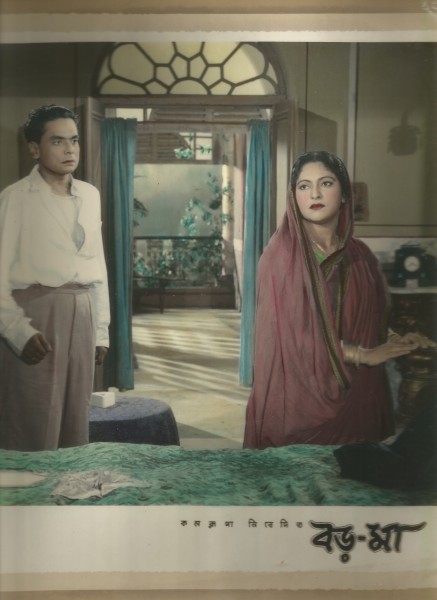I think easily the best thing to come out of being content-in-charge of Upperstall has been my exposure to Indian cinema for the sake of the site.
From the studio films of the 1930s and 1940s to the golden age of the 1950s and 60s (easily my favourite era) to the Indian New wave to Regional cinema and documentaries, I try to catch up as much as I can on the great and varied cinema culture of our country as and when I have the time. And as mentioned in my first ever entry on this blog, 12 am daily is reserved exclusively for DD Punjabi to catch up on the country’s Punjabi films as part of my great discovery of being a Punjab-da-puttar! Provided I’m awake at that time, of course.
Even as I am blown by Sivaji Ganesan’s brilliant debut in the ultimate ‘DMK’ film Parasakthi (1952) or totally charmed by Waheeda Rehman’s ‘item number’ in the Telugu film Rojulu Marayi (1955), which, incidentally, led to her being discovered by Guru Dutt, the most exciting discovery for me has been the Bengali mainstream cinema of the 1950s and 1960s. To be honest, having seen a couple of the ghastly Bengali potboilers of the 1980s and 1990s whose names or plots I, fortunately, do not recall at all, I was wary of even the older films. But thankfully, my fears were unfounded and most pleasantly so.
Like Hindi cinema, the 1950s and 60s is rightly considered the golden age of Bengali commercial cinema as well. At the FTII, I was exposed to the films of Satyajit Ray and Ritwik Ghatak but not conventional mainstream Bengali cinema. Thanks now to DVD availabilty, as I watched films like Harano Sur (1957), Deep Jele Jai (1959), Saptapadi (1961), Uttar Falguni (1963) and Saat Pake Bandha (1963), I could not help but admire what fine films they are, aesthetically, content-wise and technically matching the best of Hindi cinema, perhaps even going beyond it. I marvel today at the Uttam Kumar-Suchitra Sen on-screen chemistry which took screen romance to a poetic and subliminal level and made them one of the great romantic pairs in the country on par with Raj Kapoor-Nargis, Guru Dutt-Waheeda Rehman, Gemini Ganesan-Savithri or Dilip Kumar-Madhubala. Even a small gesture of her packing for him in Saptapadi is romance at its best. I am totally taken in by the fine work of filmmakers like Ajoy Kar, Asit Sen, Tarun Majumdar and Tapan Sinha giving Bengali cinema its distinct identity, I admire the great histrionics of actors like Uttam Kumar, Suchitra Sen, Supriya Devi, Soumitra Chatterjee, Anil Chatterjee, Sandhya Roy, Chhabi Biswas, Chhaya Devi, Bikash Roy and Pahari Sanyal.

I cannot help but repeatedly listen to Hemanta Mukherjee’s enchanting compositions like Tumi Je Amar (rendered by my favourite singer Geeta Dutt in a manner as only she could), Shuno Bondhu and Ei Path Jadi Na Shesh Hoy. I am captivated by the depth in the choice of subjects, the wonderful adaptations from Bengali literature, the mature visual nature of storytelling, the high level of film craft shown by the directors complemented by the absolutely wonderful and poetic play of light and shade achieved by the cinematographers with extremely innovative use of sound in these films. For instance, brilliant use of the telephone is made in Saat Pake Bandha as it rings at the worst of times in the Sukhendu-Archana marriage with each knowing the call is probably coming from her family. Their silence, even as the phone continues to ring loudly before one of them eventually picks it up, speaks volumes. The scene in Saptapadi where Suchitra Sen recognizes Uttam Kumar is as great a cinematic moment for me as any. Rina Brown sees Krishnendu in the mirror as he avoids facing her and as she recognises him, a train goes past, rattling the hut and his image in the mirror; all done by simulation of light on Krishnendu’s image in the mirror and sound of the train in the background – expertly visualised and executed by cinematographer-director Ajoy Kar.
I hope I have now become qualified enough to be able to say Boi Dekha or Viewed the Book as the old time Bengali cinegoer would say!



You are hereby granted an honorary Bengali identity
It’s strange that the Bengalis are perhaps the only people who call one medium by another! The reason could be that at the very beginning of feature films in Bengal a lot of literary classics – works of Bankim Chandra, Tagore, Sarat Chandra – dealing with human relationships, historical figures and events were adapted for the screen. The adaptations provided intellectual legitimacy to the new medium and also facilitated its acceptance amongst the middle classes.
Honoured Monish!
You could be right about the birth of the phrase – Boi Dekha. I remember while researching the studio system of the 1930s and 1940s, coming across how the films of New Theatres, Calcutta aimed for a cinematic equivalence of (Bengali) literature.
I second Monish and grant Karan a Bengali identity. You named some of my favourite films, moments and songs… and left me feeling horribly nostalgic.
Thanks Irene…
I didn’t know such a term existed. It sounds wonderful, ‘Boi Dekha’ and I’m going to steal it for a post I’m writing on Teja.
Looks like I have a lot of catching up to do with old Bengali films. I’m going to follow you, Karan.
Actually Batul, Monish had told me about Boi Dekha quite some time back. So in a way we both owe it to him!
And regarding classic Bengali cinema, yes do catch up on some of the films. Well worth it.
Bollyviewer,
Apart from the films I’ve mentioned in the piece (all great ones), you could watch Lookochuri, one of the best loved comedies in Bengali cinema starring Kishore Kumar, Mala Sinha and Anita Guha with lovely music by Hemanta Mukherjee, Prithibi Amara Chhaye, Indrani, Chaowa-Paowa, Sharey Chuattar, Bipasha, Shap Mochan…
Monish could add many more to the list, I’m sure.
“the most exciting discovery for me has been the Bengali mainstream cinema of the 1950s and 1960s” – Yesss! Its so much like Hollywood of the 30 and 40s. Beautiful B/W photograhy, really interesting and well done stories and dialogues and very little over-the-top melodrama. Unlike Hollywood though, they have lovely songs.
Funnily enough my discovery came about via Hemant Kumar (I had seen two Uttam-Suchitra starrers thanks to numerous Bengali friends but couldnt believe they were all so good!) – I was watching Conrad Rook’s “Siddhartha” which has a couple of Hemant Kumar’s Bangla songs (Rabindra Sangeet, I believe) and wanted more. You tube searches kept taking me to Uttam-Suchitra movie songs till I gave in and ordered a couple of their movies’ DVDs. Since then I’ve seen several of their movies with each other and with other actors and was pleasantly surprised to come across one of Soumitra Chatterjee’s mainstream films, too. Since you’re an honorary Bengali now, perhaps you’d care to recommend some good ones?
The list provided by Karan is fairly comprehensive. I would add Uttam Kumar’s ‘Agnishwar’ and Soumitra Chatterjee’s ‘Teen Bhubaner Paare’. Among Tapan Sinha’s works Kabuliwallah, Kshudita Pashan and Nirjan Saikate are pretty good. Phuleshwari, Thagini and Palatak – Tarun Majumdar’s early works are also highly recommended. Baksho Badal starring Soumitra and a very young Aparna Sen is another fine comedy… Sharey Chuattar – could be a little dicey. Cinematically is weak, its fun lies in its dialogue and its very Bengali milieu and characters.
Karan: You missed mentioning Tulsi Chakraborty – the star of Ray’s Paras Pathar (The Philosopher’s Stone) and whom he considered as one of the finest comic actors of all time.
Actually boorback, among Ray’s films haven’t seen Paras Pathar.
I’ve written about the films I have seen. Thanks for adding to the list. Will try and catch up with some of the films for sure.
Hey thanks for all the great recommendations, Karan and Monish. “Chaowa-Paowa” and “Sharey Chuattar” are already in my to-watch pile (I went on a Uttam-Suchitra DVDs shopping spree!) but will be sure to look out for the rest.
Happy viewing, bollyviewer!
U r the quintessential bangali! U’ve echoed my admiration of & thoughts on commercial bangla chobi of the 50s/60s & all those brilliant actors u’ve mentioned! I’m a huge Uttam fan.Unfortunately,these films got relegated to the bckgrnd of bengali consciousness b’cause of the ‘intellectual ‘film-buffs’ enthu for Ray/Ghatak/Mrinal Sen exclusively…big pity,that,as these films,the songs,r heritage bangla chayachobi.Its xtremely sad to learn from press reports that a lot of this cinema is either irretrievably lost or damaged…
Xcellent blog,Karan,& jokes aside,u r AMAZINGLY more bangali than the bongs themselves!!Why dont u consider a film-essay on the golden age &golden stars of this Bengali cinema? SERIOUSLY.A labour of love kind of.U’ll do a gud job I believe.
Rina,
Thanks for your feedback. Appreciate it.
have u seen ‘nimantran’ of tarun majumder?i consider it as one of the majumders finest works.
abc,
Have heard a lot about Nimantran but haven’t been able to locate a dvd or vcd of the film yet…
well, u are truly an honorary bong!! I have always maintained that the bengali cinema from the period 1950-75 was of supreme standard and infact even way better then Hindi cinema of that period, which is sort of a big achievement considering that bengali cinema neither had the big budget nor the huge market of Bolly films…. Also many of the hindi cinema classics are adaptations from bengali cinema& literature. Interestingly the period of 1950-75 was also the golden period of Hindi cinema and there too bongs had a huge contribution…. Sad to see that the pretty bad state of bengali cinema and bongs in bollyland nowadays though the likes of Shoojit Sircar, Anurag Basu, Sujoy Ghosh in hindi & Srijit Mukherjee, Kamleshwar Mukherjee, Kaushik Ganguly in bengali rank among the best of talents of indian cinema today.
P.S: The song ‘Neer Chhoto Khoti Nai’ from Indrani is composed by Nachiketa Ghosh not Hemant Kumar.
Corrected, thanks!
Yesterday, July 25 2021, I was watching Saptapadi and was disgusted by the fact that all the songs, including the famous Ei path Jodi na sesh noi were silenced. Why? It was shameful and disgusting.
You mean the songs were left out of the film? That’s strange. Apart from being great songs, it’s not fair at all to the makers to not show their original and intended work.